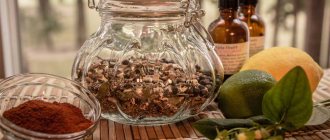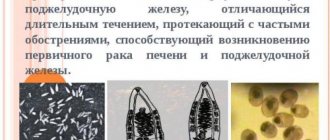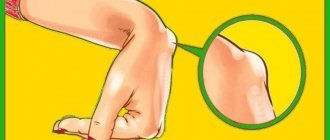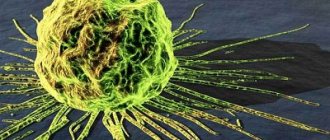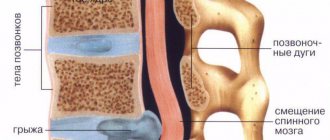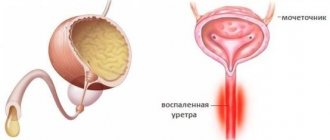- August 12, 2019
- Surgery
- Fedor Bunin
An inguinal hernia is a pathological condition in which the abdominal organs begin to bulge, forming a hernial sac. Due to anatomical abilities, it is more common in men than in women. The pathology is accompanied by pain and weakness. It can only be completely overcome through surgery. Treatment of inguinal hernia in men without surgery is prescribed in the initial stages or when radical methods are contraindicated. More details about alternative therapy options will be discussed in today's article.
Main reasons
The pathology is formed due to a violation of the strength of the groin muscles or excessive pressure on them. The main causes of inguinal hernia in men are usually divided into groups depending on the age of the patient.
In newborns it develops due to:
- prematurity, when the muscles have not had time to fully form;
- pathologies of intrauterine development;
- colic and constipation, which is accompanied by muscle strain and pressure on internal organs.
In children under one year of age, the hernia may go away on its own. As muscles grow, all structures of the body become stronger. However, in this case, there is a high probability of recurrence of the pathology in adulthood.
The causes of inguinal hernia in men (aged from one year to 60 years) can be as follows:
- congenital hernia not treated in a timely manner;
- hereditary predisposition;
- instability of body weight;
- obesity;
- genitourinary diseases;
- physical activity, lifting weights;
- weakness of the groin muscles due to surgery or lack of activity;
- injuries and abdominal injuries.
At the age of 35-40 years, the pathology occurs most often in men. After 60 years, physical inactivity, problems with bowel movements, and heavy lifting can lead to its appearance. We must not forget about age-related muscle wear.
Reasons for appearance
The development of a hernia is more likely in women who are at risk due to the presence of a predisposing factor in their lives:
- Physical inactivity. This disease manifests itself as a result of disorders of the musculoskeletal system, circulatory system, digestive system, and respiratory system.
- Tendency to inguinal hernia due to genetics.
- Weak body constitution of a woman.
But even these factors are not a reason to say that the disease will definitely manifest itself. Other provocateurs increase the likelihood of developing pathology.
| Factors | Causes |
| High pressure inside the abdominal cavity. |
|
| Weakness of the muscular system of the anterior abdominal wall. |
|
The risk group includes women aged 12-24 months and women over 40 years of age. In children, the appearance of the disease is explained either by a defect in the ligamentous apparatus or by anatomical weakness.
How to identify an inguinal hernia in men?
A hernia is a tumor-like protrusion, soft to the touch. At the initial stage, it can be easily adjusted. It grows due to increased pressure in the peritoneal cavity. For example, when coughing or laughing. The size of the protrusion varies and can resemble a nut or reach large dimensions.
Symptoms appear gradually. At first, the patient is bothered by discomfort in the groin, which disappears on its own after some time. Then the clinical picture is supplemented:
- periodic pain and heaviness in the abdomen;
- an increase in the size of the scrotum;
- intestinal dysfunction (flatulence, constipation, rumbling).
Also, urination disorders, pain above the pubic bone and in the urethra are not excluded.
Symptoms of inguinal hernia
In men, an inguinal hernia, in addition to general symptoms, has a number of specific signs. These include:
- Burning and pain in the groin area;
- Difficulty urinating, defecating;
- Sensation of the hernial sac moving into the scrotum area;
- Discomfort when walking;
- Asymmetry of the scrotum (with testicular hernia);
- Violation of potency.
The pain may radiate to the lower back and genitals. Increased negative sensations occur during times of increased physical activity, as well as abdominal pressure (for example, during bowel movements due to constipation, coughing, laughter, and so on).
In women, the symptoms are generally similar, but with a formed hernia, a protrusion forms above the pubic region, in the inguinal fold and above the labia (the localization may vary and only a doctor can accurately determine the presence of pathology and its stage). Otherwise, there are minor or increased pain that manifests itself when walking or physical activity.
It is important to understand that symptoms in the initial stages may appear periodically, but this does not mean that the pathology has gone away. The tone continues to develop until an acute condition arises with the need for urgent surgical intervention. That is why it is better to consult a doctor at the first symptoms and carry out normal treatment with alternative methods. These also include folk remedies.
Possible complications
An inguinal hernia is a serious pathology, the symptoms of which cannot be ignored. If left untreated, there is a high likelihood of complications developing.
Why is an inguinal hernia dangerous for men?
- Problems in intimate life, development of infertility.
- Hernia inflammation.
- Disruption of the gastrointestinal tract.
- Deterioration in quality of life due to constant pain.
- Strangulated hernia, resulting in:
- intestinal obstruction develops, and the accumulating feces begin to poison the body;
- appendix prolapse and inflammation;
- hernia suppuration and rupture;
- peritonitis.
A strangulated protrusion cannot be reduced independently due to the high risk of death. If the tumor changes its color to blue or purple, the patient requires immediate hospitalization.
Consequences of an inguinal hernia
Why is an inguinal hernia dangerous? Fragments of internal organs (omentum, intestine, testicle) through damage formed in the groin cavity can “fall out” into the hernial sac.
Under such circumstances, various conditions may develop - from ordinary discomfort to serious consequences.
An inguinal hernia is fraught with:
- hernia injury (may occur as a result of incorrectly performed hernia reduction);
- inflammatory processes in the hernia area;
- development of a malignant process in the area of the hernial sac;
- intestinal obstruction;
- stagnation of feces;
- strangulated hernia;
- pathologies of the reproductive system.
Hernia complications can occur at any time: the operation in this case is emergency.
Diagnostic methods
A surgeon diagnoses inguinal hernia in men. First, he conducts an external examination and palpation. The shape and size of the protrusion are assessed in a standing and lying position, then the patient is asked to cough and strain.
Additional examination may be required to obtain an expanded clinical picture. Typically it includes the following activities:
- cystography (the bladder is filled with a contrast agent, after which an image is taken);
- cystoscopy (endoscopic examination of the inner surface of the bladder);
- herniography (x-ray of the hernial sac);
- irrigoscopy (x-ray examination of the large intestine after it has been filled with a contrast agent);
- Ultrasound.
It is important to differentiate an inguinal hernia in men from varicocele, lymphadenitis, and hydrocele.
Methods for eliminating an inguinal hernia
There are 2 options for eliminating an inguinal hernia: surgical and conservative. It is possible to completely eliminate the pathology only through laparoscopic intervention.
Treatment of inguinal hernia in men without surgery is recommended for minor defects, the presence of genitourinary infections, and also in case of contraindications to surgery. The latter include:
- diseases of the cardiac system;
- hepatitis, liver cirrhosis;
- pyelonephritis in the acute stage;
- anemia, leukemia and other bleeding disorders;
- decompensated diabetes.
Conservative therapy is carried out only under the supervision of a doctor. It is important to regularly and correctly follow all his recommendations. The following methods can be used:
- wearing a bandage;
- physical exercise;
- ethnoscience;
- dieting.
Each of the options for treating inguinal hernia in men without surgery will be discussed in detail later in the article.
Why is an inguinal hernia dangerous?
An inguinal hernia in women, the symptoms of which are just beginning to appear, does not pose any danger. But during the time the hernia manifests itself, complications may develop. The most serious of them is infringement, when it is urgently necessary to contact an ambulance.
In addition to pinching, an inflammatory process may begin to develop. As a rule, it occurs along with malaise and a slight increase in temperature. Another danger of the disease is stool blockage, when part of the intestine gets into the inside of the hernial sac. This complication directly affects the functioning of all gastrointestinal organs.
Typically, blockage occurs in older people. This kind of problem can only be solved through surgery. An inguinal hernia during pregnancy does not affect the development of the fetus. Doctors remove the hernia only after the patient gives birth. The patient is operated on 3 or 6 months after birth.
Help from traditional medicine
Treatment with folk remedies for inguinal hernia in men involves the use of various decoctions, tinctures and compresses. They help relieve pain and improve general condition. It is permissible to use them only after consultation with a doctor, since there is a possibility of developing side effects.
Most often, patients use lotions to reduce swelling and relieve pain. They can be prepared using both herbs and medications. Nettle compresses are considered one of the effective remedies. To prepare, you will need to grind fresh leaves in a blender until creamy. The resulting mass is placed on a cabbage leaf and then applied to the affected area.
Also in alternative medicine, various fat-based ointments are used. They are effective only at the initial stage of pathology. Particularly popular is an ointment based on fat, raw eggs and vinegar. You will need to mix 100 ml of liquid and one chicken egg, add pre-melted pork fat (0.5 l), mix. The resulting mixture should be left in a dark place for a week. After this, it is heated, 2 quail eggs and a teaspoon of badger fat are added. The remedy can be used once a day.
Such ointments tone the muscular system, which prevents further development of the disease and strangulation of the hernia. They are applied directly to the affected area, covered with gauze. The duration of such therapy is usually about a month. It is better to store prepared ointments in the refrigerator.
Folk remedies for inguinal hernia
Traditional remedies will be effective only in the initial stages and when combined with other methods - physiotherapy, gymnastics, wearing a bandage, and so on. Let's look at the most effective recipes from the folk tradition that will help cope with an inguinal hernia.
Oak bark
An oak bark compress often helps treat the symptoms of inflammation and also has a positive effect on soft tissues. To do this, take dried bark (1 tsp), grind it and pour a glass of boiling water. Next, the mixture is placed on low heat, where the brew should simmer for about 10 minutes. At the end of the allotted time, cover the composition with a lid and let it brew until it cools.
To apply the compress correctly, you should understand that you need to apply heat. That is, gauze is moistened in a strained warm solution and applied to the site of exposure. In this case, cellophane is placed on top and secured with adhesive tape. The compress is changed every 3 hours.
Sauerkraut brine
Sauerkraut brine has an analgesic effect if used correctly. Take a bandage or gauze pad. It is folded in several layers. This cloth should be soaked generously in cabbage juice. Apply a compress to the affected area. Like the previous one, it needs to be changed every 3 hours.
Compresses from other ingredients
They can also be made from wormwood infusion. Steam the crushed herb with boiling water. Next, strain and apply to the affected area. It is worth considering that wormwood is a toxic herb, and therefore should be used less frequently than the previous ones. You can apply warm compresses 2-3 times a day.
Wormwood is one of the triad herbs (cloves, wormwood, tansy), which is prohibited for pregnant women. There is a risk of miscarriage.
The use of vinegar solution will help relieve swelling and inflammation, reduce vascular permeability and lower the local temperature. The solution is also applied to the affected area in the form of a compress according to the previous method. Vinegar 4% should be diluted as follows: 2 tbsp. per glass of water. Apply up to 3 times a day.
A fern compress couldn’t be easier to make. Take a fern leaf, knead it in your hands and use cellophane and adhesive tape to secure it to the affected area. You need to leave it on all night.
Herbal infusions
Taking herbal infusions can also help treat an inguinal hernia. A decoction is made from cornflower flowers. Add 3 tablespoons per glass of boiling water. plant raw materials. Leave to room temperature and take before meals in several doses (dividing the resulting volume by the number of meals). In the same way, decoctions are prepared from meadowsweet, gooseberry leaves, and drupes. A decoction of gooseberry leaves should be drunk up to 5 times a day.
No less effective is a decoction based on meadow clover. Prepared according to the principle of the previous remedy. It should be used at least three times a day, a third of a glass at a time.
A decoction of kupena and milk is quite simple to make, but it has an excellent anti-inflammatory effect. For half a liter of milk add 2 tbsp. raw materials. Mix cold and place over medium heat. When the mixture boils, the heat is reduced to minimum. Next, simmer the solution for another 7 minutes and then let it cool. Take 2 tbsp. up to 4 times a day.
Ointment for inguinal hernia
Ointment for inguinal hernia is considered one of the most effective among folk remedies. It is based on pork fat. Pre-mixed vinegar essence and 1 egg are added to half a kilo of melted base. Mix this mixture and place it in a cool place in a glass container for a week to infuse until it reaches the desired consistency.
Next, take out the mixture, heat it in the same container in a water bath, add 1 tbsp badger fat. and a couple of quail eggs. Mix all this thoroughly with a whisk until smooth. Keep refrigerated. Apply the ointment throughout the day by applying a napkin. Secure with cellophane or bandage, seal with adhesive tape. You need to change it every two hours throughout the day. You can use it until the condition improves.
Compresses made from nettle, cabbage and sour cream also give an excellent effect. But women need to use them with caution. It is prohibited during menstruation or in the presence of local wound surfaces, since nettle is a natural anticoagulant, that is, it thins the blood. Grind a few nettle leaves (necessarily fresh) to a paste and mix with 2 tablespoons of rich sour cream. Apply this improvised ointment to the affected area and cover with a previously rumpled fresh cabbage leaf. Sometimes cabbage is replaced with burdock leaf. Secure this product in the classic way using a cloth and adhesive.
Combination of techniques
Several methods can be combined. For example, the previously mentioned vinegar-based solution (it is better to take apple cider vinegar) and wipe the affected area with it. There is no need to rub in, as there is a risk of tissue deterioration and injury to the skin. It is enough to simply wet the affected area with cotton wool soaked in the solution. Afterwards, wait until it dries on its own and then apply a compress of oak bark.
At the same time, you can take any of the above infusions orally. It is important to understand that you cannot interfere with everything at once, since the use of several compresses, ointments or infusions can provoke the development of side effects. You need to use such recipes for inguinal hernia as carefully as possible. There should be no pain during the procedure. If third-party symptoms are identified, then the therapeutic effect on the inguinal hernia using folk remedies is stopped.
Internal use of folk remedies: herbal infusions
Treatment of inguinal hernia with folk remedies is carried out not only locally. Various infusions can be used internally. They have analgesic properties, tone the body, and increase immunity. In addition, they help get rid of symptoms of other diseases of the genitourinary system.
How to treat an inguinal hernia with infusions? Recipes using larch bark are characterized by the greatest effectiveness. To prepare it, pour 100 g of bark with a glass of boiling water and let it brew in a warm place for about two hours. Then the product needs to be filtered. Consume it in small portions before meals. Therapy lasts 6 months with weekly breaks.
Folk remedies
Treatment of inguinal hernia with folk remedies in men has several types. At home, you can prepare various remedies that will help significantly reduce the protrusion in size.
The main methods of treating PG involve the use of:
- ointments and creams prepared independently;
- compresses from plant juices and herbal extracts;
- decoctions and infusions.
Recipes of folk remedies for the treatment of inguinal hernia in men
Compresses for the treatment of PG in men:
- It is necessary to pick fresh nettle and grind its leaves in a blender, place the prepared pulp on gauze and apply to the protrusion. It is recommended to do the compress regularly 2 – 3 times a day. Keep for 20 minutes.
- Sauerkraut brine can be applied to the area of the protrusion. If there is no brine, then you should squeeze the juice from fresh cabbage leaves and apply such a compress to the hernia for 30 minutes. The procedure may be associated with some discomfort, minor pain and burning of the skin.
- You can also make a compress from aloe leaves. It is applied to education. It is advisable to apply the compress at night every day for 1–2 months.
Using a bandage
The bandage is recommended for use by all patients. Especially if surgery is contraindicated or there is a high risk of hernia strangulation. It should be purchased only after consultation with a surgeon. He will be able to determine the appropriate size.
In some cases, the use of a bandage is contraindicated because the patient:
- irreducible hernia;
- excess body weight;
- diabetes;
- neoplasms in the groin area of various etiologies;
- violation of the integrity of the skin in the groin.
The bandage should only be worn while lying down, when the muscles are relaxed and the hernia is reduced into place. At the initial stage of the pathological process, its help is resorted to only when playing sports and other physical activities. In advanced cases, the bandage is worn regularly, removed only during water procedures. If the likelihood of complications is negligible, it can be removed at night and during the day. However, before doing this, you must consult a surgeon.
Principles of treatment of inguinal hernia
At any stage of the disease, complete reduction of the organ can only be achieved by surgical treatment, but the risk of relapse of the pathology remains . Questions about whether an inguinal hernia can go away on its own are absolutely inappropriate.
At the initial stages of development of an inguinal hernia (ICD code 10 - 40), when there is no infringement yet, treatment without surgery is possible.
It can be based on several principles:
- taking medications;
- physiotherapy;
- use of orthopedic bandages;
- physiotherapy;
- dosed physical activity;
- use of folk remedies.
Certain treatment methods are acceptable for use at home. But before treating an inguinal hernia with unconventional methods, you should find out the stage of development of the disease .
Exercise therapy complex
Treatment of inguinal hernia in men without surgery also involves performing physical therapy exercises. The complex selected by the doctor allows you to strengthen the ligaments and muscles of the abdominal wall, restore blood flow and lymph outflow. As a result of its regular implementation, tissue nutrition is noticeably improved and pain is relieved.
The most effective exercises are listed below:
- Plank. From a lying position, you should raise your torso above the floor, while leaning on your feet and elbows. You need to remain in this position for up to 10 seconds.
- Scissors. You need to take a lying position, put your arms along your body. Raise your legs above the floor at an angle of 45 degrees and cross them, imitating scissors. Repeat 15-20 times.
- Bike. Starting position as in the previous exercise. In this case, you need to raise your legs and make movements like when riding a bicycle for 15-20 seconds.
Exercise therapy is not recommended if the hernia is pinched or if pain occurs.
Changing your diet
Diet is an integral component of therapy. Doctors give the following recommendations regarding food intake:
- Meals should be fractional. Overeating is not allowed.
- The diet should be dominated by foods rich in fiber, lean meats and fish, broths and water-based porridges.
- It is better to avoid foods that cause bloating, flatulence, and constipation. We are talking about fried and fatty foods, spicy, salty and poorly digestible foods. You will also have to give up carbonated drinks, alcohol, strong tea and coffee.
- The consumption of baked goods, fermented milk products and bread should be reduced to small doses.
Compliance with these recommendations allows you to normalize stool and digestion. At the same time, the intestines will not be overloaded. If necessary, the doctor may prescribe herbal laxatives. All these measures help eliminate excess pressure inside the peritoneum, which reduces the likelihood of progression of the disease.
Prevention methods
Non-surgical methods for treating inguinal hernia in men are effective only at the initial stage of the pathology. Such therapy usually lasts about a year. In case of complete recovery, it is necessary to adhere to certain rules of prevention to prevent relapse:
- Visit your surgeon twice a year to monitor your health.
- Do not lift heavy objects and avoid playing sports without using a special bandage.
- Do strengthening exercises daily.
- Control body weight.
- Stick to a healthy diet.
- Treat all diseases in a timely manner.
Your doctor should tell you how to treat an inguinal hernia. Today, this pathology can be overcome with non-surgical methods. However, in this case the risk of relapse increases. Therefore, if symptoms return or the condition worsens, you should prepare for surgery.
Compresses and applications
The hernia cannot be heated, so compresses made from plant materials are applied at a temperature no higher than 35° C. The best method of preparation is an aqueous decoction from a multi-component collection.
Collection No. 1. Urban gravilate, common groundsel, black root, cat's foot, white sweet clover, tartar.
Collection No. 2. Spotted orchis, creeping clover, white acacia, summer adonis, umbellate wintergreen, knotweed, common chickweed.
From the listed herbs, prepare a water decoction (for 100 g of raw material, 1 liter of boiling water, bring to a boil, leave for 12 hours), in which cotton cloth is moistened and applied to the area of the hernial opening. The top is covered with compress paper and secured with a bandage. Keep the compress for at least 6-10 hours.
To avoid enlargement and strangulation of the inguinal hernia, it is necessary to wear a special bandage, which is selected by the doctor. If after using folk remedies the hernia does not decrease, then you should consult a doctor.

